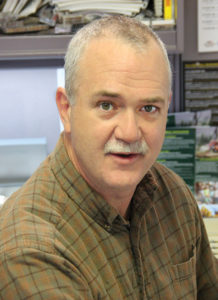Oregon Facing Danger Signs
Article by Dan Shell, Senior Editor, Timber Processing April 2024
 The state may be the top U.S. lumber producer right now, but log supply in Oregon the past 30 years or so has been an uneasy balance of private, federal (Forest Service and Bureau of Land Management) and state timberlands. Now, with state and private timber owners taking a regulatory harvest reduction, it’s more important than ever for federal officials to meet—and ideally increase—timber harvest levels to help maintain that balance.
The state may be the top U.S. lumber producer right now, but log supply in Oregon the past 30 years or so has been an uneasy balance of private, federal (Forest Service and Bureau of Land Management) and state timberlands. Now, with state and private timber owners taking a regulatory harvest reduction, it’s more important than ever for federal officials to meet—and ideally increase—timber harvest levels to help maintain that balance.
Officials with the American Forest Resource Council (AFRC) are sounding the alarm after three mill closures announced in Oregon this year: Hampton Lumber’s Banks mill, Interfor’s Philomath mill, and a two-year sawmill closure announced by Rosboro in Springfield while a new glulam plant is being constructed. In all three cases, the companies involved cited ongoing uncertainty over log supply as contributing to the closure decisions.
Also adding to raw material concerns is the ongoing impact of Oregon’s September 2020 wildfires that burned 971,000 acres of timberland and destroyed 15 billion BF of green timber with more than $30 billion in end-product value, according to an Oregon Forest Resources Institute report.
AFRC President Travis Joseph and organization members are urging the Pacific Northwest congressional delegation to take steps to help reverse the trend of more mill closures. This includes more active oversight to ensure the FS and BLM meet and increase timber harvest goals.
Maintaining a healthy and robust forest industry sector is also a key component of addressing federal forest health and wildfire issues. An additional $6 billion outlay to the FS and BLM to increase the pace and scope of forest treatments and stewardship projects hasn’t yielded an uptick in log supply that traditionally accompanies such projects, Joseph says, noting that the BLM’s western Oregon timber sale program this year has been arbitrarily reduced by more than 25%.
The group is also taking the long view on the issue of maintaining a vibrant forest industry sector. The cautionary tale is Arizona, where years of federal forest management neglect allowed forest industry infrastructure to almost disappear. And now, the state is still struggling to develop the timber processing and utilization facilities to make a difference in forest health operations.
There’s also the role of wood building materials and other wood products that sequester carbon permanently and help decarbonization efforts. It’s a sustainable industry that produces sustainable products.
Joseph adds: “If the Federal Government is going to be successful in addressing the current federal forest health and wildfire crises – and protect the extraordinary social, environmental, economic, and cultural values of our public lands – it must sustain and grow the forest infrastructure and related workforces.”
Latest News
Proposed California Pellet Mills Refocusing
Proposed California Pellet Mills RefocusingNumerous environmental groups are gleefully self-praising over the announcement that Golden State Natural Resources (GSNR) is backing away from building two large industrial wood pellet mills in California—a mill in the...
Rayonier Fights City Of Fernandina Beach Over Bioethanol Production
Rayonier Fights City Of Fernandina Beach Over Bioethanol ProductionRayonier Performance Fibers, LLC (also known as RYAM or Rayonier Advanced Materials) has filed lawsuits against the city of Fernandina Beach, Fla. and the board of City Commissioners for what Rayonier...
Western Forest Products Columbia Vista Mill Sustains Major Fire Damage
Western Forest Products Columbia Vista Mill Sustains Major Fire DamageLongtime lumber producer Columbia Vista in Vancouver, Wa. sustained major damage in a July 6 fire that has left the mill completely inoperable. According to firefighter reports, a fire started in...
Forisk Promotes Amanda Lang To President & COO
Forisk Promotes Amanda Lang To President & COO Forisk Consulting, a leading provider of forestry industry analytics and research, has announced further growth and updates to its leadership team. Amanda Lang has been promoted to President & Chief Operating...
Hampton Goes With Comact In South Carolina
Hampton Goes With Comact In South CarolinaComact has been selected as the equipment and technology supplier for Hampton Lumber’s new state-of-the-art sawmill in South Carolina. In addition to supplying the mill’s advanced systems, Comact will be responsible for...
Find Us On Social
Newsletter
The monthly Timber Processing Industry Newsletter reaches over 4,000 mill owners and supervisors.
Subscribe/Renew
Timber Processing is delivered 10 times per year to subscribers who represent sawmill ownership, management and supervisory personnel and corporate executives. Subscriptions are FREE to qualified individuals.
Advertise
Complete the online form so we can direct you to the appropriate Sales Representative.
